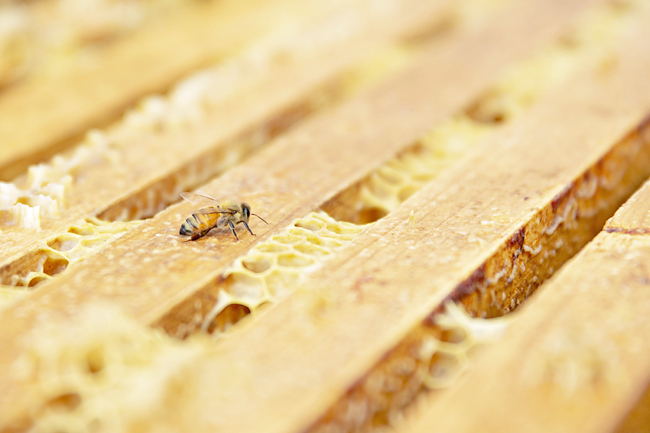BLOOMBERG – On a sunny afternoon in December, Angelita De la Luz placed a honeybee into a tube at a laboratory in Buenos Aires, Argentina. Soon after, a pump released a small, scented puff of air and researchers watched for a very specific reaction, a scent that would make the bee stick out its tongue.
“This tells us that the bee recognises the volatile we are testing as a meaningful signal from the plant, that there is good food to be found,” said the leader of a field testing at California-based biotech start-up Beeflow De la Luz. A volatile is a floral characteristic that attracts honeybees, among other functions. Once Beeflow identifies the right one, De la Luz and her colleagues will develop it into bee feed used to “train” honey bees to pollinate targetted crops.
That training is part of Beeflow’s solution to a multibillion-dollar challenge facing farmers today. As extreme weather, habitat loss and pesticides continue to kill off honeybees, an insect critical for turning flowers into fruits, scientists are figuring out how to safeguard the remaining population and maximise its pollination potential. For Beeflow, that means essentially crafting better diets for bees. Just like humans taking supplements for their health, the company regularly feeds its honeybees a supplement designed to enhance their immune system. Composed of amino acids collected from floral nectar as well as plant-based hormones, it allows honeybees to carry out as many as seven times more flights in cold weather, according to the company, and more than double their usual pollen load.
From there, Beeflow uses a different supplement to effectively set the bees’ “flight GPS” to specific crops.
So far, the company has deployed its solution across 10,000 acres of farmland in the United States (US), Argentina, Mexico and Peru.

Beeflow says its pollination service has produced an average increase of 32 per cent in crop yields compared to conventional farms, based on 50-plus field tests with blueberries, almonds and raspberries. Since it was founded in 2016, the company has raised USD13 million from investors that include Ospraie Ag Science, SOSV and Grid Exponential. It’s in the process of securing more funding to scale up operations.
Over the past two decades, the bee population has been declining all over the world. Habitat loss, toxic pesticides and, increasingly, a changing climate are impacting various species of wild bees, including bumblebees.
But even honeybees under the care of commercial beekeepers are affected.
In the US alone, beekeepers lost an estimated 39 per cent of their honeybee colonies over the 12 months ending in April 2022, according to an annual survey. Roughly two thirds of the world’s crops rely on honeybees and other pollinators, and one recent study found that insufficient pollination is causing about 500,000 early deaths a year.
Several companies are working to find a fix. Boston-based GreenLight Biosciences developed a vaccine to protect honeybees from a deadly parasite.
In Ireland, ApisProtect installs in-hive sensors to alert beekeepers when unhealthy bees are identified. Veon, Russia’s third-largest mobile-phone company, offers a warning system for pesticide distribution, a main cause of death for Russian bees.
Beeflow, for its part, is tackling just one part of the challenge, getting honeybees to do more work in cold weather.
While honeybees naturally become less active as temperatures drop, more frequent cold snaps caused by climate change mean that beekeepers and growers will have to find ways to overcome that limitation.
Once Beeflow has made a bee stronger, it must then ensure the bee is applying its strength to the targetted crop, with no wildflower distractions along the way.
That’s accomplished by giving the bees a treat, specifically, sugar syrup, whenever they’re exposed to the scent associated with the crop they need to pollinate. Founder of Beeflow Matias Viel, likens this conditioning to Ivan Pavlov’s classic experiment in getting dogs to salivate at the sound of a bell. Since honeybees have short memories, Beeflow resets their conditioning every two weeks during pollination season.
It took Beeflow more than three years and over 1,000 lab tests to identify and create a synthetic version of the exact floral volatile of blueberry that signals food for honeybees, De la Luz said. But the start-up’s patience appears to be paying off. Beeflow says its two supplements, combined with strategic placement of beehives in farmland, help increase blueberry yields by up to 60 per cent. The company also offers commercial pollination services for almonds and cherries, and said it has seen increased yields for both.
“It’s the most promising technology that I’ve seen,” said an assistant professor at Washington State University Lisa Wasko DeVetter who specialises in small fruit cultivation and has been tracking Beeflow’s field work since 2021.
Last year, DeVetter found that Washington state blueberry farms deploying Beeflow technology produced fruits 30 per cent larger in size than those without it. DeVetter said more research is needed to assess the technology’s overall impact on bee health.
Getting farmers on board could also be an uphill battle, she warns, as conventional pollination practices have dominated farmland for decades. The price tag doesn’t help, either. Beeflow charges USD750 per acre for blueberry pollination in states such as Washington, roughly three times higher than conventional pollination services there.
Beeflow’s Viel said the company’s growing body of field tests is helping convince growers, as is the constraint on fertiliser supply prompted by the COVID-19 pandemic and Russia’s invasion of Ukraine. The company has yet to turn a profit, and won’t disclose its revenue but Viel said it expanded its workforce to more than 40 people this year, up from 12 employees in 2020.
Beeflow is eyeing further expansion in the US next year, and aims to enter the European market by 2025.





